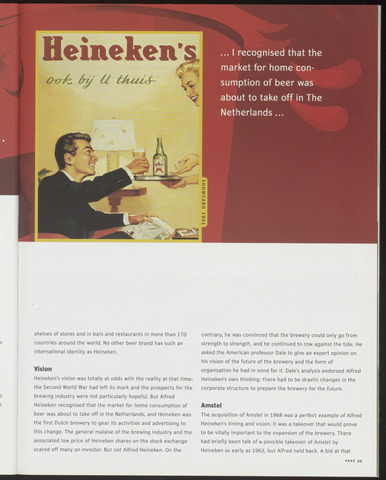I recognised that the
market for home con
sumption of beer was
about to take off in The
Netherlands
Ox>/z bp' U t/vuóS-
Vision
Amstel
Heineken's.
shelves of stores and in bars and restaurants in more than 170
countries around the world. No other beer brand has such an
international identity as Heineken.
Heineken's vision was totally at odds with the reality at that time:
the Second World War had left its mark and the prospects for the
brewing industry were not particularly hopeful. But Alfred
Heineken recognised that the market for home consumption of
beer was about to take off in the Netherlands, and Heineken was
the first Dutch brewery to gear its activities and advertising to
this change. The general malaise of the brewing industry and the
associated low price of Heineken shares on the stock exchange
scared off many an investor. But not Alfred Heineken. On the
contrary, he was convinced that the brewery could only go from
strength to strength, and he continued to row against the tide. He
asked the American professor Dale to give an expert opinion on
his vision of the future of the brewery and the form of
organisation he had in mind for it. Dale's analysis endorsed Alfred
Heineken's own thinking: there had to be drastic changes in the
corporate structure to prepare the brewery for the future.
The acquisition of Amstel in 1968 was a perfect example of Alfred
Heineken's timing and vision. It was a takeover that would prove
to be vitally important to the expansion of the brewery. There
had briefly been talk of a possible takeover of Amstel by
Heineken as early as 1963, but Alfred held back. A bid at that
PAGE 35

